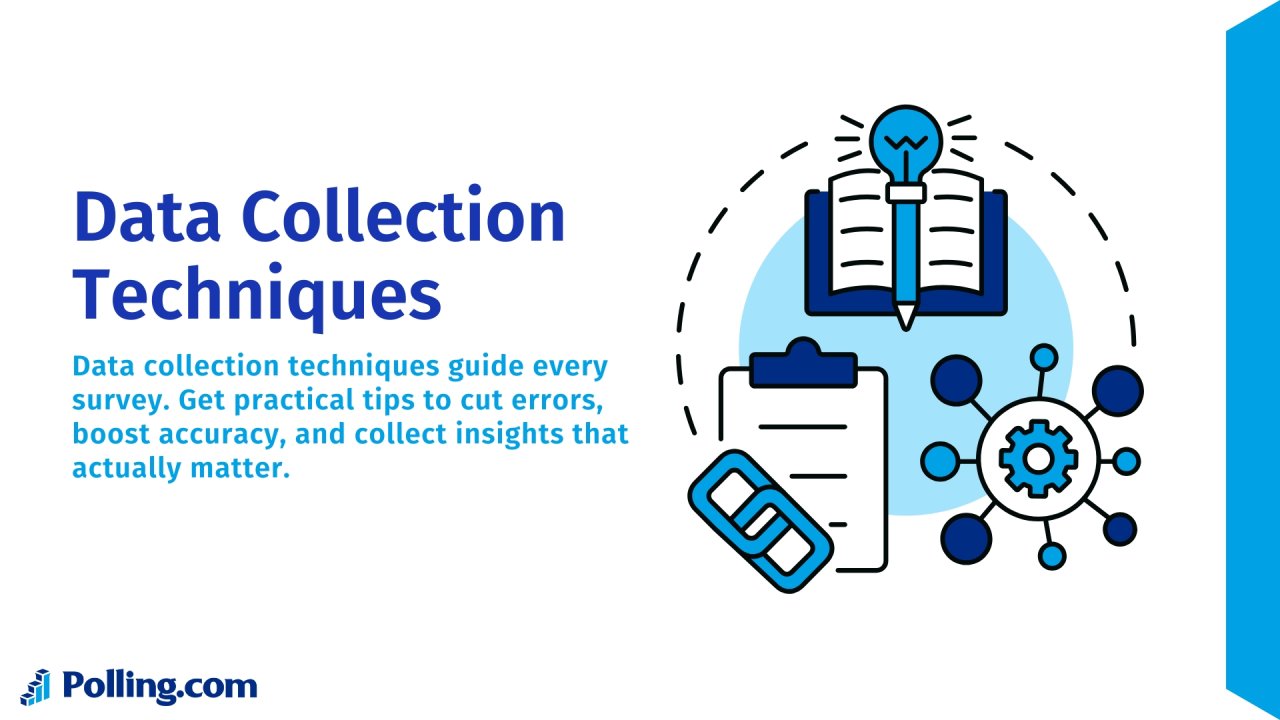
Data Collection Techniques: How to Get Accurate Survey Results
In a world driven by data, the quality of every decision depends on the quality of the information behind it.
That’s where data collection comes in.
At its simplest, data collection is the process of gathering information from respondents, customers, or users so businesses, researchers, and policymakers can turn raw numbers or feedback into meaningful insights.
But not all data is created equal. The way you collect it (or the techniques you use) directly affects the quality of your results.
A poorly designed survey or biased sample can lead to flawed conclusions, while accurate, well-executed methods can drive smarter product development, sharper marketing strategies, and more effective policies.
This is where platforms like Polling.com step in.
With powerful yet user-friendly survey tools, Polling.com makes it easier for organizations to design, distribute, and analyze surveys in real time.
In this article, we’ll go through the most important data collection techniques in research, how they’re used, and how to choose the right one for your goals.
What Are Data Collection Techniques?
Data collection techniques are the structured methods used to gather information from a target audience.
They answer the “how” of data gathering, whether that’s through surveys, interviews, focus groups, or digital tracking.
It’s important to distinguish between techniques and tools:
- Techniques are the approaches or methodologies (surveys, structured observation, etc.)
- Tools are the actual platforms or instruments used to apply those techniques (Polling.com’s survey builder, Google Forms, etc.)
Together, these techniques and tools form the foundation of the data lifecycle:
- Collection: A method to collect data from respondents, such as gathering raw survey responses through the chosen technique.
- Analysis: Interpreting patterns and extracting insights.
- Decision-making: Applying findings to guide strategy, policy, or innovation.
Here’s how data collection techniques show up across different industries:
- Political polling: Opinion surveys, voter sentiment analysis, real-time pulse checks.
- Market research: Customer satisfaction surveys, product feedback, A/B testing.
- Academic research: Structured interviews, ethnographic studies, behavioral observation.
When used thoughtfully, these techniques not only capture responses but also unlock stories and trends that raw numbers alone can’t reveal.
Classifying Data Collection Techniques
Every research project has different goals, and primary data collection techniques depend on whether you’re chasing numbers or narratives.
That’s why data collection is generally grouped into two categories: quantitative and qualitative techniques.
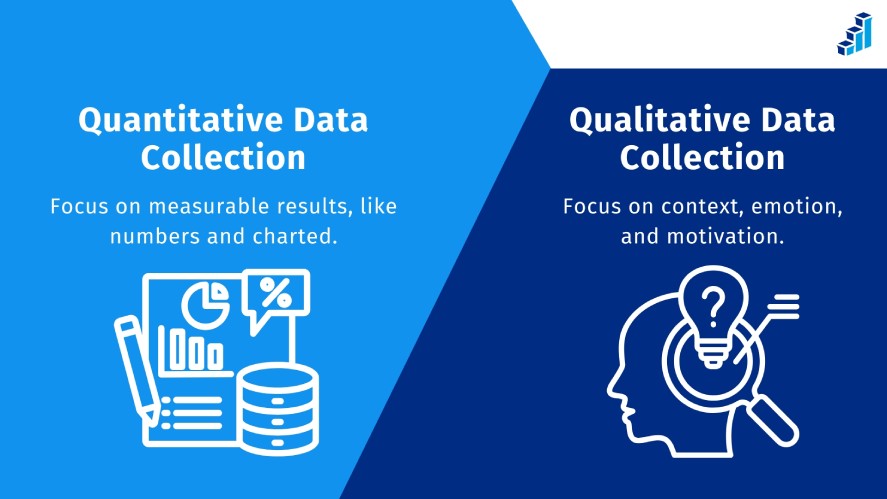
Quantitative Data Collection Techniques
Quantitative methods focus on measurable results, like numbers that can be compared, charted, and analyzed statistically. They work best when you want clarity at scale.
Surveys and questionnaires are the most popular survey method of data collection examples.
With a platform like Polling.com, teams can launch an NPS survey after a product launch or run a political poll with real-time dashboards.
The strength of surveys lies in their reach: hundreds or thousands of responses collected quickly, then sliced and analyzed for patterns.
Structured interviews also fall under this category. Here, every respondent is asked the same set of questions, ensuring answers can be measured against each other.
Similarly, experiments like A/B testing two versions of a checkout flow give clear cause-and-effect data.
And when researchers need behavioral data, structured observation provides counts of specific actions, such as how many shoppers stop at a display or how often users click a button.
Qualitative Data Collection Techniques
Qualitative data methods, by contrast, dig into the why.
They don’t focus on metrics but instead on context, emotion, and motivation. These data collection techniques are valuable for understanding customer sentiment or social behaviors.
Focus groups are a classic example. A moderator leads a small group through open-ended discussions, revealing collective attitudes toward a product or brand.
In-depth interviews go further, creating space for one-on-one conversations that uncover nuanced perspectives, such as why voters feel attached to a candidate, not just whether they support them.
Ethnographic studies, unstructured observations, and applied behavior analysis data collection methods offer yet another angle.
By immersing themselves in a natural environment or observing without predefined checklists, researchers can uncover unexpected insights like how families really use a new tech device or where customers struggle during onboarding.
Data Collection Techniques by Medium
Beyond the choice between quantitative and qualitative, another key decision is how data is collected: online or offline.
Each medium comes with its own strengths, limitations, and best-fit scenarios.
Most modern research uses a blend of both, but knowing where each shines helps ensure you’re reaching the right audience with the right method.
Online Data Collection Methods
Digital channels have become the default for many organizations thanks to their speed, reach, and automation.
Online methods include digital surveys, social media polls, and mobile app feedback forms, all of which allow you to gather responses at scale in a fraction of the time traditional approaches require.
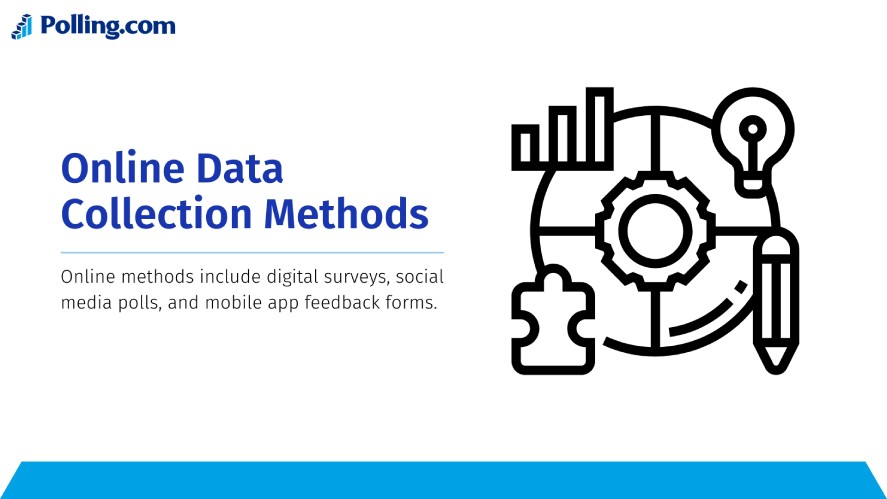
The main advantages here are speed, scalability, and cost efficiency.
Responses can be collected instantly, data is automatically stored and processed, and results can be segmented in real time.
For businesses that need agility, like SaaS teams launching new features, online methods are hard to beat.
This is where Polling.com data collection has a clear edge.
Its survey builder makes it simple to create engaging polls, while real-time analytics dashboards deliver insights the moment responses come in.
Whether you’re running a nationwide political poll or a quick customer satisfaction check, online methods powered by Polling.com give you both precision and efficiency.
Offline Data Collection Methods
Not every audience can be reached online, and not every research goal is best served by digital tools.
That’s where offline methods, like paper surveys, in-person interviews, and hands-on experiments, still prove their value.
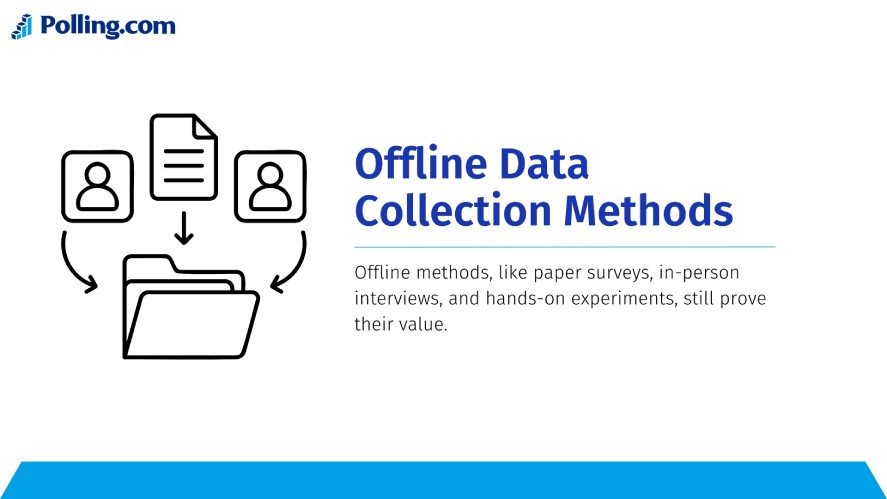
The strength of offline techniques lies in their personal touch.
A face-to-face interview allows researchers to read body language, ask follow-up questions, and build trust in ways a digital form simply can’t.
Paper surveys, on the other hand, remain practical in classrooms, events, or regions with limited internet access.
Of course, offline data collection comes with trade-offs. It takes more time, requires more staff, and often means extra steps for data entry.
But when human connection and accessibility are priorities, offline methods deliver insights that are deeper and sometimes more reliable than what you’d get from an online-only approach.
Choosing the Right Data Collection Method
Selecting the right data collection techniques, methodology and survey method, starts with understanding your objective.
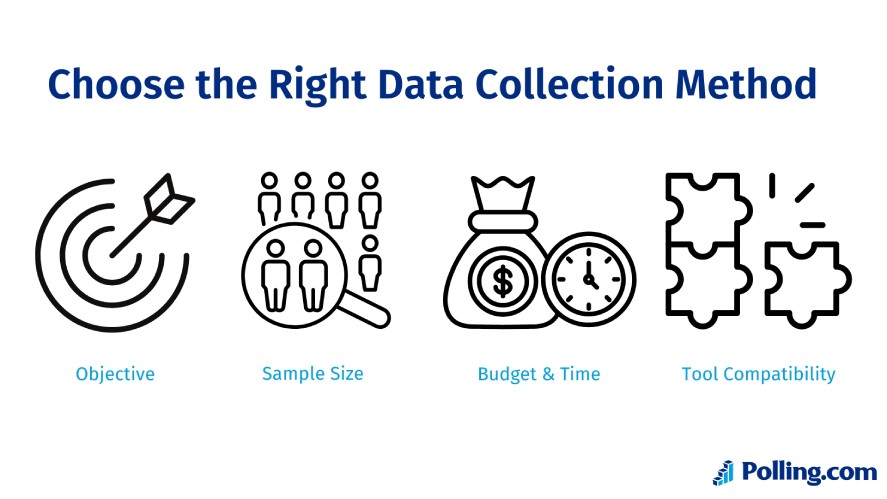
If the goal is to explore a new idea or uncover hidden motivations, qualitative techniques such as focus groups or in-depth interviews work best.
When the aim is to describe a trend across a larger audience, surveys or structured observations provide a clearer picture.
And if you’re testing cause-and-effect relationships, experiments are the strongest option.
Your sample size and audience also matter.
A nationwide political poll requires thousands of responses to ensure accuracy, while a B2B company gathering feedback from existing clients may only need a handful of detailed conversations.
Budget and time can be decisive, too.
In-person interviews deliver richer insights but are resource-intensive, while online surveys can be launched and analyzed in days at a fraction of the cost.
This is where platforms like Polling.com shine, making it easy to set up professional surveys with templates, logic branching, and real-time analytics.
Finally, think about tool compatibility. Even the best research design will fall flat without the right technology to support it.
Polling.com’s survey builder ensures that your chosen method, whether exploratory, descriptive, or causal, translates into usable, high-quality results.
Example Scenarios
Here are a few survey examples with data and real-world situations to consider.
During an election year, a campaign might lean on large-scale online polling platform to capture voter sentiment quickly and track changes over time.
A SaaS company launching a new feature could deploy an NPS survey to measure customer loyalty and gather improvement ideas.
Meanwhile, a brand planning a major rebrand may turn to focus groups, where face-to-face discussions reveal emotional reactions that numbers alone can’t capture.
Tools for Effective Data Collection
Gathering data can be messy if you don’t have the right tools.
That’s why choosing a survey and polling software isn’t just about convenience; it’s about making sure the data you collect actually helps you move forward.
Polling.com — Your All-in-One Survey Platform
When it comes to modern survey software, Polling.com stands out as a comprehensive solution.
The platform combines customizable templates, a free online survey creator, and a powerful survey analytics dashboard that turns raw survey responses into actionable insights.
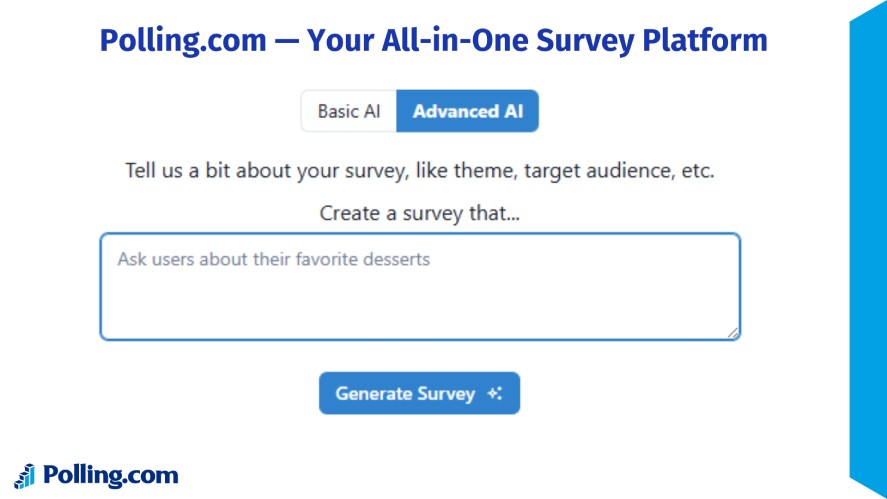
With AI-powered recommendations, Polling.com helps you spot trends, optimize question design, and even forecast potential outcomes.
Real-world applications are wide-ranging.
A SaaS company can launch an NPS survey within minutes using a customer feedback platform to measure loyalty.
HR teams can gather employee feedback with a user feedback platform to track engagement and morale.
Political organizations can run pulse checks across key demographics, analyzing voter sentiment in real time.
Whatever the use case, Polling.com’s customer feedback tools make it simple to gather quality data at scale without technical hurdles.
Other Survey Tools to Consider
Of course, Polling.com isn’t the only option. Depending on your needs, other survey platforms may be useful:
- Google Forms: Free and easy to use, ideal for quick and simple surveys.
- Typeform: Visually engaging and interactive, great for improving response rates.
- SurveyMonkey: Feature-rich with strong brand recognition, commonly used in corporate settings.
While these best survey tools offer value, Polling.com survey brings an edge with its AI insights, advanced analytics, and free business analytics software scalability.
For teams that need more than just form creation, especially those focused on decision-making speed and accuracy, Polling.com offers a more robust, future-ready solution.
Ethics and Compliance in Data Collection
When you ask people to share their information, you’re asking for trust. That’s why ethics should sit at the heart of every data collection effort.
Participants deserve to know why you’re collecting their responses, how the data will be used, and whether their privacy will be protected.
Clear, consent, respect for anonymity, and strong data safeguards aren’t just best practices; they’re obligations.
Regulations like GDPR in Europe or HIPAA in the U.S. make these responsibilities even more concrete, setting strict rules around how personal or sensitive data must be handled.
Ignoring them isn’t just risky legally, as it erodes credibility with your audience.
Polling.com, as a customer feedback management tool, helps organizations navigate this landscape by building privacy and compliance features directly into the platform, so researchers can uphold ethical standards without slowing down the survey process.
Common Challenges in Data Collection
Running surveys sounds simple, but real-world data collection rarely goes perfectly.
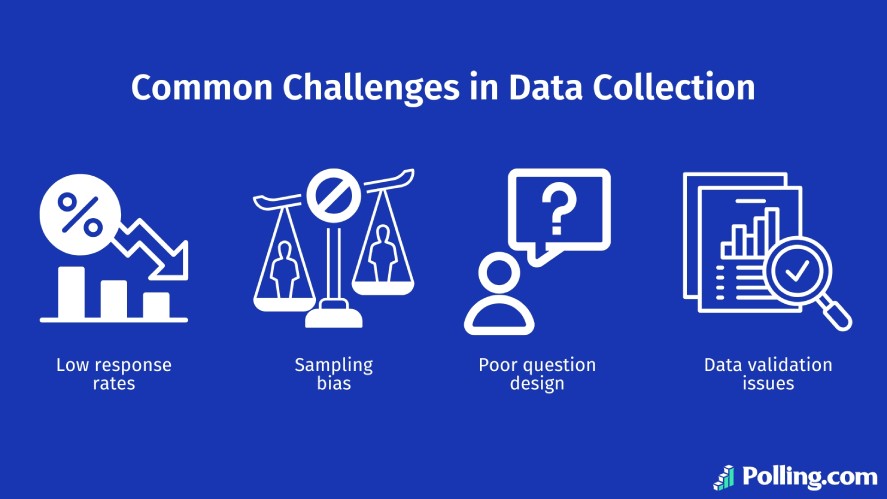
Perple may not respond, or the wrong audience might skew the survey and results. Sometimes the questions themselves introduce bias, or the data collected is messy and unreliable.
Each of these issues can weaken the insights you’re trying to gain.
The key is to anticipate problems before they undermine your survey.
Polling.com makes this easier by offering feedback tools like A/B testing to fine-tune questions for clarity and engagement, as well as pre-survey trials that reveal confusing wording before it reaches a wide audience.
Targeted respondent selection and built-in data validation further reduce bias and errors.
With these guardrails in place, challenges become opportunities to sharpen your research rather than roadblocks to trustworthy results.
Best Practices for High-Quality Data Collection
The quality of your survey results depends on how you design and deliver the question types for surveys.
Long, complicated surveys often lose participants halfway through, so keeping things short and focused is essential.
Each question should serve a clear purpose, phrased in a way that avoids bias and confusion.
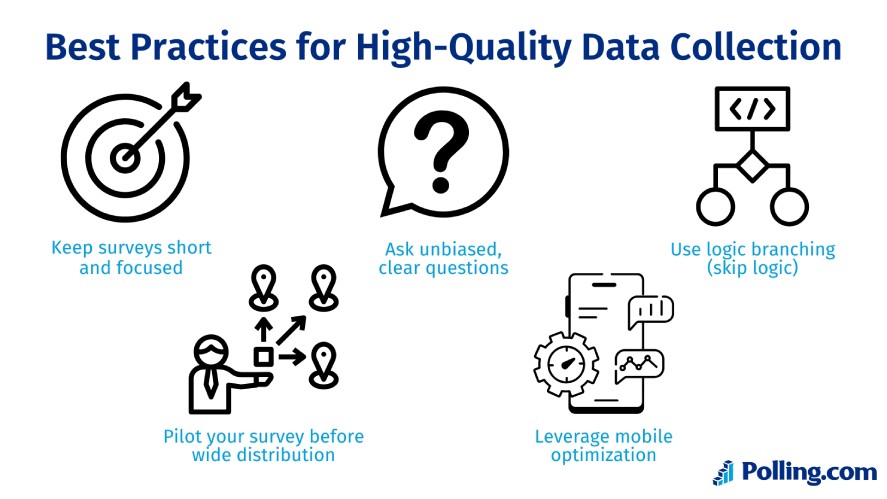
Using skip logic (also called logic branching) ensures respondents only see questions relevant to them, which keeps the experience smpoth and improves accuracy.
Before sending a survey to a wide audience, piloting it with product feedback tools and a small group can reveal gaps, unclear wording, or technical hiccups you may have missed.
And because so many people now respond from their phones, mobile optimization is no longer optional; it’s a baseline requirement.
Polling.com bakes these best practices directly into the platform: surveys are mobile-ready by default, skip logic is simple to set up, and pilot testing is quick to run.
By automating much of the heavy lifting, Polling.com helps you focus less on mechanics and more on gathering reliable insights.
How Data Collection Techniques May Evolve
The way organizations collect data has changed dramatically.
Where surveys once meant long forms and manual number-crunching, today’s approaches are more dynamic and interactive.
AI and machine learning, combined with big data collection techniques, make it possible for surveys to evolve in real time, customizing questions for each respondent.
Voice-enabled inputs bring a conversational feel, while advanced sentiment analysis can capture not only what people say, but how they feel.
Beyond survey-level feedback, predictive polling powered by vast data sets is helping organizations anticipate behavior and spot emerging trends.
This evolution is redefining what surveys can achieve.
Platforms such as Polling.com are leading the way, combining the trustworthiness of traditional survey methods with cutting-edge technologies to deliver deeper insights at speed.
Conclusion
Collecting great data has always been about asking the right questions in the right way. However, the data collection techniques available to do so are evolving quickly.
From AI-powered insights to mobile-first survey experiences, the tools you choose can make all the difference in the quality of the feedback you receive.
Polling.com helps bridge that gap by automating best practices and offering flexible survey options that grow with your needs.
If you’re ready to see how much easier and more effective your data collection can be, try Polling.com’s free online survey builder today!
